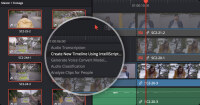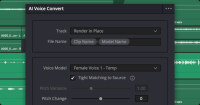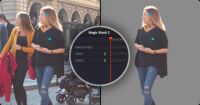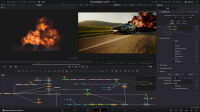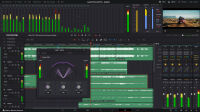[22:20 Fri,4.April 2025 by blip] |
In addition to the new Pyxis 12K, Blackmagic has, of course, also unveiled the traditional spring update of its free grading, editing, compositing, and audio mastering software DaVinci Resolve at NAB. And this time, it’s packed with new features—over 100 new additions, including numerous AI tools, such as scene extension, script-based rough cutting, automatic audio mixing, music adjustment, voice swapping, and much more—the scope of these new tools is simply overwhelming. The video introduction to the new Resolve features starts in the livestream after more than 2 hours What&s New in DaVinci Resolve 20 - Editing and Montage The editing and montage modules now feature a dedicated keyframe editor and a voiceover function. The latter allows you to record a voiceover track during timeline playback. Users get cue, record, and stop controls, as well as quick access to voice isolation and dialog leveling tools. A dedicated track is automatically added, and users can load teleprompter scripts and work with a countdown. The new keyframe editor is designed to offer more precise parameters for animation. Users can use keyframe curves and parameters to edit keyframes and adjust animation curves with simple controls. To review and navigate keyframes, users can also use the keyframe tray beneath the timeline. The Text+ tool has been updated and now supports additional layout styles. To work with individual layers of PSD files in the timeline, users can now split their layers in place. With the Inspector tabs, users can set individual style parameters for each text layer. The text list allows users to navigate, reorder, lock, and delete layers. Other updates in the editing module include the ability to drag clips directly into the viewer to overwrite a camera angle in the timeline live, as well as a safe trim mode that prevents important changes from being accidentally overwritten. Additionally, the editing module now includes a full-featured audio mixer with a professional level meter. Each channel strip has a pan slider from left to right, a fader, a solo and mute button, as well as professional panning, EQ, dynamics, and FX controls. In the Color Module, there’s now Chroma Warp, which allows you to intuitively adjust color and saturation with a single movement in the viewer. The stroke control shifts the colors in one direction, while the point-to-point mode isolates areas for more precise color correction. Users can add points to highlight areas they don’t want to adjust. New AI Tools, Including Generative AI Around 10 new AI-based tools are now included in Resolve, some of which are generative, such as AI Set Extender: this tool allows you to expand image content from a simple text prompt. The area to be extended is marked, and missing parts are automatically generated. Users can even create new backgrounds behind objects in the foreground. The quality of the generated parts remains to be seen, as well as whether these compute-intensive tasks—if cloud-based—will come with a fee. More detailed information is pending; while many, not all, AI functions will be usable locally. AI-powered IntelliScript, on the other hand, creates an entire timeline draft based on a text script. AI IntelliScript matches the transcribed audio in media clips to the script and creates a timeline with the best selected takes. Alternative takes are placed on additional tracks so editors can review them. With AI Animated Subtitles, users can automatically animate subtitle words as they are spoken. Animated Fusion title templates are then pulled into the track header to modify the appearance and animation style of the text. For multicam shoots, AI Multicam SmartSwitch automatically switches between multicam angles on the timeline depending on the speaker in the scene. It analyzes and selects clip angles based on audio and lip movements in the video. In the audio domain, several AI helpers have been added. AI IntelliCut automates time-consuming tasks in seconds through clip-based audio processing. "Remove Silence" deletes low-level or silent areas to produce cleaner tracks. For individual mixing, users can split dialog into separate tracks per speaker and create an ADR list to replace dialog. The AI Audio Assistant analyzes the audio in the timeline and creates a “professional” audio mix, while AI Music Extender automatically adjusts the length of a music track to fit a video. The audio clip is analyzed, and the music cut is either extended or shortened. Users receive four versions to choose from, visual cut markers, and the ability to split clip sections. There&s also a new function, AI Detect Music Beats, which makes it easier to cut to music. Audio clips with beat-heavy music are analyzed, and markers are automatically set to indicate beats. Users can use these as visual indicators for cut points or pull clips to the nearest beat marker. For better audio consistency, AI Dialogue Matcher automatically matches the tone, volume, and room ambience of two completely different dialog clips—if successful, this would be a real help during editing. With AI Voice Convert, pre-generated voice models can be applied to an existing voice recording, while preserving tonal variations, pitch shifts, and emotions. Voices recorded in noisy environments can be optimized, and perfect ADRs with an actor’s voice can be created—without needing the actor to go to a studio. Some existing AI tools have been enhanced. For instance, SuperScale now offers 3x and 4x upscaling, which ensures the highest visual quality for all media in a project, regardless of source resolution, such as when working with archive material or stock footage that needs to be adjusted to the delivery resolution. AI Magic Mask has been updated for even more precise tracking within a mode. A selection can be refined faster using points to select people, objects, regions, and paint tools. Magic Mask intuitively tracks the movement of a selected area, even with obstacles and low-quality clips. The AI Depth Map effect has also been updated for faster scene analysis and more practical mattes. Foreground figures can be quickly separated from their background, or lens blur can be simulated on the background. For grading, mattes can be refined and specific depths isolated. Fusion Fusion now offers Deep-Image-Compositing tools that allow access to depth data in EXR files. A range of new nodes enables merging, transforming, scaling, cropping, recoloring, and generating holdouts. Conversely, EXR files with depth data can also be exported from the Fusion 3D environment via the "Saver" node. Fusion also now supports multi-layer EXR files or Photoshop files and offers a preview of the layers in the viewer. Additionally, Fusion can access and edit all layers in the nodes. Through the MediaOut node, a preview of the subsequent clip grading can now be shown directly in the Fusion module. This allows you to review the final composition without leaving the Fusion module. A new MultiPoly tool displays all used masks in a single list, saving time when switching between nodes, thus enabling faster and more precise rotoscoping. With uVolume, volumetric VDB files can be directly imported into Fusion, avoiding time-consuming conversions. This ensures creative control over imported effects like smoke, fire, clouds, and explosions. Moreover, new Optical Flow/Vector tools (Flow Vector-Warp, Vector-Transform, and Vector-Denoise) have been integrated, enabling complex temporal effects using motion vectors. Blackmagic Cloud New features in Blackmagic Cloud include cloud folders, which allow you to share additional clips, images, or graphics for a project with other team members. All cloud content is displayed as virtual clips and folders until used in a project, at which point it is synced locally. The cloud storage has also been updated with an icon view. Customers without a Blackmagic Cloud account can now be given presentation access to review projects. To activate guest access, users simply generate a URL link to the presentation to be reviewed and share it with clients. Users can review clips, make notes with markers on the timeline, and even conduct group chats. Audio and Fairlight The clip EQ now features 6 bands in the editing, montage, and Fairlight modules, allowing for better sound control at the clip level, similar to track EQ on the mixing console. Fairlight now includes two new options for clip editing. Users can match the audio level or frequency spectrum of a target clip to a reference clip. The EQ match is dynamic and is automatically applied throughout the entire clip to maintain tonal balance. The Level Matcher enables seamless clip section transitions without manual adjustments. If users have favorite plugins that are often applied in a chain, they can now create a Chain FX, set it with preferred settings, and save it as a preset. Up to 6 effects can be used per chain, or Chain FX plugins can be combined in the effect slots of a channel for longer chains. Fairlight now includes an automation mode per channel, providing more flexibility and creative control when mixing projects. Users can now dynamically adjust multiple individual tracks in one pass while automating some channels in Snap, Latch, and others in Trim. And Also... For remote streaming, users now have the option to display Power Windows and other overlays on the reference monitor—useful for remote workflows when the grading system, colorist, or client and their local monitor are at different locations. Users can now also stream in H.265 4:2:2. When working with portrait format material, the layouts for the editing, montage, and color modules are automatically rearranged to optimize working with a vertical viewer. DaVinci Resolve Studio 20 now includes new tools and parameters for Apple Immersive Workflows, including support for spatial audio. This means users can import clips recorded with a Blackmagic URSA Cine Immersive Camera to edit, mix, and professionally deliver media for Apple Vision Pro. Bilder zur Newsmeldung:
deutsche Version dieser Seite: Blackmagic DaVinci Resolve 20 mit über 100 (!) neuen Funktionen vorgestellt |









